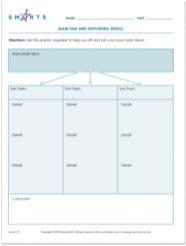Research Institute for Learning and Development www.researchild.org www.smarts-ef.org 3 8 THANNUAL E XECUTIVE F UNCTION C ONFERENCE EXECUTIVE FUNCTION , MOTIVATION, AND ENGAGEMENT: Fostering Social-Emotional Learn ing and Positive Behavior in Students LYNN MELTZER, Ph. D., CONF E RENCE FOUNDER AND CHAIR VIRT UAL CONFERENCE NOVEMBER 9 & 10 , 202 3 — O NLINE RESEA R CHILD
Executive Function, Motivation, and Engagement: Fostering Social-Emotional Learning and Positive Behavior in Students

Information for Faculty: Logistics, Due Dates, Sample Materials
Table of contents
1. Day of the Conference
2. Information We Need for the Conference Binder
3. Due Dates
4. Other General Information
5. Attachments
1. Day of the Conference

- Please join your Zoom session no later than 15 minutes before your presentation starts where you will be greeted by Elizabeth Ross. Elizabeth can address any Zoom issues that may arise so that you can start your presentation smoothly.
- Make sure you close all other background programs running on your computer and restart your computer. Your background room should be clear of clutter.
- Your presentation should be 45-50 min to leave room for the Q & A. Our tech person will come onto your Zoom to give you a heads-up as to how much time you have left. You will have support from our tech person during your entire presentation should any problems arise.
- During your presentation, the moderator will be collecting questions from the participants and will read them during the Q&A period.
- Your presentations will be "live" on Zoom.
2. Information We Need for the Conference Binder
Samples of these are available in the “Attachments “ section of this brochure
Short Bio
- Please submit your biographical sketch (approx. 100-200 words) for our conference materials. This information provides participants with general information about your work, research interests and other relevant information.
Headshot Photo
- Please make sure that your photo is as high a resolution as possible.
Cell Phone Number (should we need to reach you on the day of the conference)
Overview of Your Presentation
- Please provide a brief overview of your session. This information should include a description of learning objectives, the “logic” behind the structure and/or sequencing of your session, and/or any other points you feel are important. This information is designed to provide participants with a general orientation to your presentation. This will be included in the conference binder.
PowerPoint Slides
- Please provide your PowerPoint Presentation and we will format it into a fillable PDF handout with space for notes.

One Article for Reprint
- Please provide (in digital format) a relevant article or chapter you have written. If you have not authored one, please include a relevant article that may be of interest to your participants. It is necessary to obtain copyright permission from the publisher for a digital inclusion in the conference binder. I attached a sample permission request letter for the publisher.
List of References
- Please send any websites, articles, bibliographies, book titles or any relevant resources for your participants, should they want to explore more information on your topic.
W-9 Form Returned
- Please indicate to whom the check should be addressed and to what address the honorarium should be sent.
3. Due Dates
June 30th, 2023
- Headshot
- Cell phone number
- Affiliation
- Short bio
October 10th, 2023
- Overview of your presentation
- Article for reprint (with permission from the publisher)
- List of references
October 20th, 2023
- PowerPoint slides

November 5th, 2023
- Completed W-9 Form
4. Other General Information
- Your access to the entire conference, as well as the Zoom link for your presentation, will be sent to you as we get closer to the conference.
- We will record your presentation and have it available (exclusively for the participants) from November 2, 2023, until January 15, 2024.

- Although we have all become familiar with Zoom, below is a link on “How to Give a Great Presentation on Zoom.” Elizabeth Ross, our staff tech expert, has fabulous ideas to make your talk even more dynamic, and includes info on lighting, sound, background, connecting, and engaging your audience. We ask that you please review the video below before you prepare your presentation.
https://youtu.be/eX LQPERedY
5. Attachments
- Sample of bio
- Sample of overview, references, and resources

-
-
Sample PowerPoint slides
Sample permissions letter for publisher
-
Sample article or chapter for reprint
le of Faculty Bios

Fac l Bio
L Me e , Ph.D., D I L D ( ILD & ILD) L , MA. F P -P I

A L D . F P C
A E F C , ( L D C ) 36 . F 30 , A E
H G E A A P D
C D . H 40 , , , .
H , , , E
F E : F P (2018), P E F
C (2010) P P C : E L (2015), - K H . ILD , MA , - E F P M / C C ( . - . ). , I
, 2015 I P A CHADD (C
D D ). A h S. Ba hi , Ph.D., CCC-SLP, A F L
A
O
E
C
E
.
- . D a B e
L M A C , N . 25 E . B C A . M . B M E L D . M . B DA
C E A . C L D O A
A
B C L L P
. H C A D
C . H
H D . B
, M.S.,
Sample of Session Overview, References, and Resources
(print and/or digital)
We format the overview, references, and resources.

E ec i e f nc ion and o gani a ion: Unlocking den abili o a o gani ed
Michael G e chle , M.Ed.
SMARTS D , R a ILD
E a a S a , I L a a D
Shell Le , M.Ed., M.S.


SMARTS C C a & T a , R a ILD
E a a S a , I L a a D
O e ie
E ec i e f nc ion processes pla a cr cial role in s den s academic s ccess from elemen ar school, hro gh high school and in o college. Ho e er, hen i comes o organi a ion, s den s are of en resis an and n illing o p in he necessar ime i akes o s a organi ed. Wha s more, he do no nders and he amo n of ime and energ heir eachers, and o her ad l s, p in o organi ing ime and ma erials in heir da - o-da li es. Wh are s den s so resis an o s a ing organi ed? Ho can e each s ra egies ha help s den s organi e heir ime and ma erials? And ho can eachers e amine heir o n organi a ion s s ems o be er s ppor he s ccess of all of heir s den s?
This orkshop ill foc s on a s of helping s den s nders and he impor ance of organi a ion, modeling s ccess, and promo ing s ra egic and organi ed learning en ironmen s. Disc ssion and hands-on ac i i ies ill emphasi e ho o empo er s den s o ac i el engage i h organi ing s ra egies. The orkshop ill incl de lesson plans, s ra eg orkshee s, hando s, and o her ma erials from he SMARTS E ec i e F nc ion c rric l m adap ed for elemen ar , middle, and high school-aged s den s. The session ill emphasi e prac ical classroom approaches ha in egra e s ra eg ins r c ion and self- nders anding in o da - o-da classroom ac i i ies hro gh he organi a ion of ma erials and ime managemen . Refe ence Brans e er, Rebecca. T
E
G C E F
Pa '
D : S a H Y C A T Ma a S , F , a
O a a N S S a L . Adams Media, 2014.
Cook, J lia, and Michelle Ha el ood H de. I Ca ' F M W a a a a !! Na ional Cen er for Yo h Iss es, 2019.
Da son, Peg, and Richard G are. W -S a A a P a : W I , G I D / PEG Da a R a G a . The G ilford Press, 2017.
L hco -Haims, J lie. H Ra a A : B a F O a T a a
P a Y K S . Sain Mar in's Griffin, 2016.
Mel er, L.J. (Ed) (2018). E F E a : F T P a (2nd ed.).
Ne York: G ilford Press.
Mel er, L.J. (2015). Teaching E ec i e F nc ion Processes: Promo ing me acogni ion, s ra eg se and effor . In Golds ein, S. & Naglieri, S. (Eds.) Ha b E F (445-475). Ne York: Springer.
Mel er, L.J., Basho, S., Redd , R., & K rk l, K. (2015). The role of men oring in fos ering e ec i e f nc ion processes, effor , and resilience. I a a J a R a L a D ab . 2(2), 91-123.

Mel er, L.J., Greschler, M., K rk l, K., S ace , W., Ross, E., & Sno , E. (2015). SMARTS E ec i e F nc ion and Men oring Program, .smar s-ef.org
Mel er, L., Greschler, M., K rk l, K., & S ace , W. (2015). E ec i e f nc ion and peer men oring: Fos ering me acogni i e a areness, effor , and academic s ccess. In Harris, K. & Mel er, L.J. (Eds.) T P P : E a L a , D , & S a S . Ne York: G ilford Press.
Mel er, L., Redd , R., Greschler, M., & K rk l, K. (2013, J ne). In L Mel er (Chair). E a : T a . Paper deli ered a The 37 h Ann al Conference of he In erna ional Academ for research in Learning Disabili ies, Bos on, MA.
Nadea , Ka hleen G., and Charles Be l. L a P a a B O a : E F

S K A /H . Magina ion Press/American Ps chological Associa ion, 2016.
Webina
Greschler, M. & Le , S. (2020) E ec i e F nc ion and Organi a ion. SMARTS - Online
Webinar: E ec i e F nc ion and Organi a ion - Yo T be
Greschler, M. & Da is, K. (2018) E ec i e F nc ion and Goal Se ing. h ps:// . o be.com/ a ch? =AXlonYrF N

Greschler, M. & Ross, E. (2020). Unders anding E ec i e F nc ion. SMARTSUnders anding E ec i e F nc ion: The Ke o S ccessf l Learning - Yo T be

Greschler, M., Goomer, R., & Mannino, K. (2020). Closing Eq i and Achie emen Gaps i h
E ec i e F nc ion S ra eg Ins r c ion. E ec i e F nc ion, Achie emen , and Eq i
Webinar - Yo T be
Re o ce
B bbl. s: Idea eb
Google Keep: Cap re ha is on o r mind. Add no es, lis s, pho os and a dio o organi e o r life.
M Home ork S den Planner: h ps://m home orkapp.com/
Pomodoro Timer: Pomodoro Timer Online - Pomofoc s
Time Timer : Vis al imer ha sho s he passage of ime.
Todois : a o-do lis app ha helps se deadlines e c.
Fo addi ional info ma ion, i i h :// . ma -ef.o g o follo on T i e @ ma online o Yo T be @ SMARTS E ec i e F nc ion
Sample of PowerPoint Presentation
(Once we receive presenters' slides, we create the handout with space for notes)

EXECUTIVE FUNCTION & MENTORING PROGRAM

Executive function and organization: Unlocking students’ ability to stay organized



ORGANIZING
Agenda
• Defining Organization
• Students’ Perspectives
• 4 C’s: Organizing Materials
•
• PPCQ: Prioritizing Studying
So, what exactly is organization?

Michael Greschler, M.Ed.
Shelly Levy, M.Ed., M.S. © ResearchILD, 2021
www.smarts-ef.org; www.researchild.org



1
MichaelGreschler, M.Ed. SMARTS Director ResearchILD Educational Specialist, ILD
RCHILD, 2020 WWW.R RCHILD.ORG| 4 MILITIA DRIVE, SUITE 20 LEXINGTON, MA 02421 781-861-3711
Shelly Levy, M.Ed., M.S. SMARTS Curriculum Coordinator & Trainer ResearchILD Educational Specialist, ILD
Obligations, Aspirations, and Negotiations: Prioritizing Time
© RESEARCHILD, 2020 WWW.RESEARCHILD.ORG| 4 MILITIA DRIVE, SUITE 20 LEXINGTON, MA 02421 781-861-3711
Sample Request Letter for Publisher

Sample Request Letter for Publisher
Dear ,
I am contacting you to request permission to reprint an article that (I or Dr. Smith) authored that was published in the ‘Journal for Multicultural Education’ in support of my presentation at the upcoming 38th Annual Executive Function Conference on November 9-10, 2023, which will be hosted by the Research Institute for Learning and Development.
This selection will be included in the digital binder that will go exclusively to the 200+ conference participants. We do not sell these binders separately.
The article we would like to include in our conference binder is:
Krishnan, K., Li, C., Kruger, L., Kimble, E., Aki, G. and Ruah, R. (2019), "Self-regulated learning in English-language learners who are persisting despite failure on a high school exit exam", Journal for Multicultural Education, Vol. 13 No. 2, pp. 140-154.
https://doi.org/10.1108/JME-03-2018-0015
A return email will be sufficient permission.
Please let me know if there is any further information I can provide in support of this request.
Thank you,
Sample Chapter for Reprint

(publisher
permission was provided)
Edited by Lynn Meltzer.
Creating Strategic Classrooms and Schools

Embedding Executive Function Strategies in the Curriculum
LYNN MELTZER
Academic performance in our 21st-century digital schools is increasingly dependent on students’ ability to set goals, organize, prioritize, shift flexibly, access working memory, and self-monitor, all processes that are critically important from elementary school through college (Barkley, 2012; Brown, 2006, 2014; Denckla, 2007; Meltzer, 2007, 2014). These executive function (EF) processes are the underpinnings for accurate and efficient performance in school, especially for those academic tasks that require students to integrate and synthesize multiple subskills, namely, reading comprehension, writing, studying, test taking, and long-term projects (Brown, 2014; Goldstein & Naglieri, 2014; Meltzer, 2013, 2014; Meltzer & Basho, 2010; Meltzer, Reddy, Greschler, & Kurkul, 2013).
This chapter provides an overview of research-based EF strategies that are important for all students and are critically important for students with learning and attention difficulties. These strategies are most effective when they are taught explicitly and integrated into the classroom curriculum. The first section focuses on a theoretical framework
26 3 11
From Executive Function in Education: From Theory to Practice, Second Edition
Copyright © 2018 The Guilford Press. All rights reserved.
PROCESSES IN READING AND OTHER CONTENT AREAS
for understanding metacognition and EF processes and their impact on students’ effort, resilience, and academic performance (Meltzer, 2014; Meltzer, Basho, Reddy, & Kurkul, 2015). The second section addresses techniques for promoting metacognitive awareness and embedding EF processes into the curriculum in five core areas: goal setting, cognitive flexibility, organizing and prioritizing, accessing working memory, and self-monitoring. The connections between students’ self-understanding and use of EF strategies, on the one hand, and their attention and emotional regulation in the classroom, on the other hand, are also discussed briefly. The third and final section describes the SMARTS Executive Function and Mentoring Program (Meltzer, Greschler, Stacey, et al., 2015) a research-based EF curriculum that provides teachers with procedures and materials for integrating EF strategies into the curriculum (Meltzer, 2014, 2015; Meltzer, Basho, et al., 2015; Meltzer, Greschler, Kurkul, & Stacey, 2015).
EXECUTIVE FUNCTION AND ACADEMIC PERFORMANCE
I’m naturally smart. I have a lot of common sense. But I’m not very organized and I procrastinate a lot. Executive function strategies helped me shift perspectives and understand myself better. I wish I had learned this stuff when I was younger. I could have used it throughout school.
—KYL E , 10 T H GRADE R
As discussed in Part I of this book, EF is a multifaceted construct or “umbrella term” for the complex cognitive processes that underlie flexible, goal-directed responses in novel or difficult situations (Anderson, 2002; Barkley, 2010, 2012; Denckla, 2007; Goldstein & Naglieri, 2014; Meltzer, 2007, 2010). The core EF processes that influence academic performance include goal setting, cognitive flexibility/shifting, organizing and prioritizing, working memory, and self-monitoring (Meltzer, 2007, 2010, 2014; Meltzer, Greschler, Kurkul, et al., 2015; Meltzer, Greschler, Stacey, et al., 2015) (see Table 11.1 for definitions).
These EF processes often affect students’ ability to complete academic tasks that involve synthesis and integration such as initiating writing assignments, summarizing information, taking notes, completing projects with multiple parts, studying, and submitting work on time (Barkley, 2010; Dawson & Guare, 2010; Denckla, 2007; Denckla & Mahone, Chapter 1, this volume; Meltzer, 2010, 2014; Meltzer & Basho, 2010; Meltzer, Dunstan-Brewer, & Krishnan, Chapter 5, this volume). Academic tasks that are often challenging for students with EF weaknesses are listed in Table 11.2.
264
TABLE 11.1. EF Processes Defined
Goal Setting: Identifying short-term and long-term objectives. Figuring out a purpose and end-point.
Cognitive Flexibility/Shifting: Switching easily between approaches. Looking again, in a brand new way.
Prioritizing and Organizing: Ordering based on relative importance and arranging information systematically. Identifying what’s most important and sorting and categorizing information.
Accessing Working Memory: Juggling information mentally. Juggling information and ideas in one’s mind.
Self-Monitoring: Identifying errors and self-correcting. Finding and fixing one’s own mistakes.
Note. Copyright 2014 by ResearchILD. Reprinted by permission.
Students who struggle with these EF processes often experience frustration and failure, and begin to feel that their brains are “clogged” with information. The paradigm that we use to explain these difficulties is based on the analogy of a “clogged funnel,” as is discussed in greater detail in Chapter 5 (Figure 5.1, repeated here as Figure 11.1).
Instruction that emphasizes EF strategies can help students to “unclog the funnel,” and prevent increasing difficulties as the complexity and pace of the curriculum intensify. A comprehensive discussion of these EF weaknesses can be found in my book, Promoting Executive Function in the Classroom (Meltzer, 2010), and strategies for teaching specific EF processes can be found in our recently launched SMARTS Online Executive Function Curriculum (Meltzer, Greschler, Stacey, et al., 2015; www.smarts-ef.org).
PROMOTING EXECUTIVE FUNCTION ACROSS THE GRADES
Executive function strategies helped me learn that, even when things are hard, I can do them. I can use strategies to make things easier. If there is a really hard word problem in math, I can read the problem and then rewrite the problem in my own way. Then it’s easy.
—JORDAN , E IG H T H GRADE R
Explicit strategy instruction benefits all students and is essential for students with learning and attention difficulties (Mastropieri & Scruggs, 2014; Meltzer 2013, 2014; Meltzer, Katzir, Miller, Reddy, & Roditi,
Creating Strategic Classrooms and Schools 265
Research Institute for Learning and Development www.researchild.org smarts-ef.org
38 T H ANN U AL EX E CUTIVE FUNCTION CONFERENC E EXECUTIVE FUNCTIO N, MOTIVATION, AND ENGAGEME NT F ostering Social - E motional Learnin g and Positive Be ha vior in Stude nts
RESEA R CHILD


















